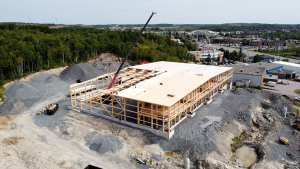Mass timber buildings are in the headlines but despite the movement’s positives of high-performance, sustainability, low-embodied energy and esthetics, the “knowledge gap” in the building industry is stunting the sector’s potential growth.
Architects Dorothy Johns and Yash Vyas have been researching how big that gap is and what can be done to close it.
The pair, who are conducting PhD research at Toronto Metropolitan University (TMU) into the hygrothermal performance and durability of mass timber, have collected 90 responses to a Canadian construction industry survey on the subject with some surprising results.
From the survey’s 11 questions on the perceived barriers and benefits primarily to using cross-laminated timber (CLT), less than 10 per cent of the respondents indicated they had “significant experience” or familiarity with CLT and only 58 per cent were aware of the product, Vyas told a seminar audience at the 16th Canadian Conference on Building Science and Technology (CCBST).
Two thirds of those polled were architects, designers, engineers or building consultants.
The majority of respondents thought there was a market for CLT but said skilled labour shortages and supply chain issues were deterrents to usage.
They also suggested unknowns about the material’s durability, embodied carbon and structural integrity were concerns, Vyas told the seminar audience.
“What Dorothy and I believe is that through research and through innovations…we can solve most of the issues the industry has around perceived constraints.”
Johns told seminar attendees many polled in the survey didn’t see mass timber as a replacement to concrete or steel.
A challenge for builders is to involve subtrades at the design stage to ensure constructability, costing and scheduling of trades, she added.
Other concerns raised were the potential moisture damage to CLT during assembly in the field. Building code limitations particularly to height and fire were also issues, Johns said.
Research by the two architects, which has included site visits, indicates manufacturers are increasingly playing a role to help builders work through assembly issues and moisture mitigation.
The architects research covers experimental and in-situ study, including the use of sensor technologies to evaluate hygrothermal performance.
While mass timber projects have been around since the 2000s in Canada, Johns said the sector is still young in Ontario and issues that crop up don’t always reflect the market in Europe where mass timber was borne a decade or so earlier.
Performance of vacuum-insulated panels explored
The performance of vacuum-insulated panels (VIPs) was a seminar topic presented by Brock Conley of Natural Resources Canada at the CCBST conference hosted recently in Woodbridge by the Ontario Building Envelope Council.
VIPs have typically been used for refrigeration in shipping containers, for example, “places where space is at a premium,” but Conley is part of a research team looking at the viability of the panels in new and retrofit homes.
Comprised of a thin vacuum insulated porous core in a metallic envelope, VIPs offer eight to 10 times more thermal resistance than conventional insulation, he told the audience.
To date his research in Ottawa, which started in 2016, has shown that VIPs in a two-by-four wall have an insulation value of more than RSI 8. That has exceeded his expectations.
While moisture was elevated inside the test building, it was acceptable as long as interior humidity levels were controlled, he said. The panels are vapour-impermeable and they can cause moisture issues in a building envelope if not tightly installed.
Furthermore, if a panel is punctured during installation, its thermal performance can drop by up to 50 per cent. Other issues include low bridging characteristics around a building perimeter and the long-term durability remains unknown, Conley told the audience.
The findings to date show VIPs are well suited to prefabricated buildings, he said, noting ongoing research in Ottawa is being conducted with others, including Carleton University.











Recent Comments